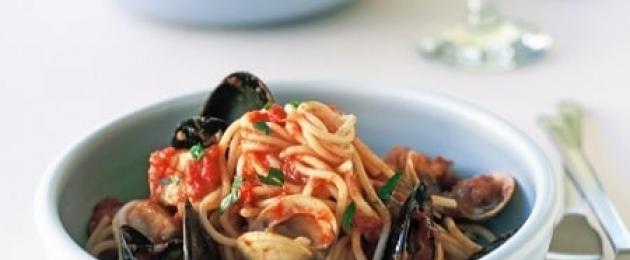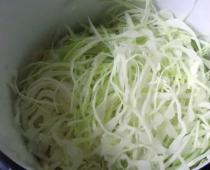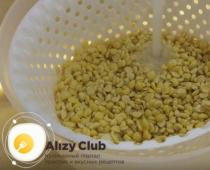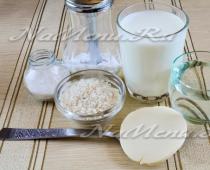Pasta with seafood, as traditions and more than a hundred different interpretations of a rather simple, at first glance, Italian cuisine recipe show, is one of the most popular dishes not only in any trattoria, but also in every restaurant or cafe. Not a single Italian restaurant can do without pasta with seafood today. Despite the ease of preparation, it is one of the most expensive due to the abundance of marine ingredients, and for all its satiety, it is one of the most useful. fashion time- how to cook pasta with seafood.
History
Most often, pasta with seafood is complemented by the famous Italian marinara sauce. According to legend, a surprisingly juicy tomato sauce was invented by ship cooks in the middle of the 16th century, literally immediately after the first appearance in Europe of tomatoes brought by the Spaniards. It was believed that due to the high concentration of acid in tomatoes, the sauce could retain its nutritional properties and excellent taste for a long time during long voyages. For the first time about tomato sauce with spices mentioned in the legendary cookbook Lo Scalo alla Moderna written by the chef Antonio Latini in 1692. The classic composition of marinara sauce is fresh tomatoes, garlic, herbs (especially basil) and onions. But today the sauce has several dozen variations: someone adds capers to it, someone finely cuts olives, and someone even seasons it with anchovies. It is believed that seafood is best combined with marinara tomato sauce - in the company of tomatoes, scallops, mussels and shrimp acquire an even richer taste.
Cooking features
The most common type of pasta for a seafood recipe is spaghetti. The ideal width of the pasta and its gutta-percha in the plate ensure the right temperature of the dish and the right texture - spaghetti, richly seasoned with sauce, does not stick together or clump, but is evenly distributed on the plate along with small seafood. Two options for cooking pasta with seafood - with and without tomato marinara sauce. Some people use a thick white sauce based on butter and cream for spaghetti with a sea cocktail, but this recipe is less and less common due to its fat content and heavy on the stomach. The second most popular option for cooking spaghetti with seafood is a dish seasoned not with sauce, but with plain olive oil. This recipe allows you to feel the taste of each of the seafood. Seafood itself differs in composition from recipe to recipe: sometimes tiger prawns can play their role, sometimes just mussels, but most often - a “soup set” of mussels, shrimp, scallops, squid, octopus and sometimes langoustines or lobster.
fashion time offers the most classic seafood pasta recipe.
500 g spaghetti
750 g seafood (250 g mussels, 250 g shrimp and 250 g shellfish or 750 g frozen sea cocktail)
2 large ripe tomatoes
2 heads of garlic
6 art. l. olive oil
1 finely chopped onion
125 ml dry white wine
50 g tomato paste
1 bunch finely chopped Italian parsley
½ lemon
200 g parmesan crumbs
A pinch of sea salt
Pinch of freshly ground black pepper
Instruments: you will need 3 deep pans, one of which is large for spaghetti, a colander, a bowl.
Cooking time: preparation - 30 minutes, cooking - 15 minutes.
Cooking method:
Dip the seafood in warm water and set aside for 20 minutes. Peel and wash the shrimp if you are preparing them separately from the sea cocktail. In a medium saucepan, heat 3 tbsp. l. olive oil, add finely chopped onion and garlic and sauté until soft (about 4 minutes). Prepare the chopped tomatoes in advance and add them to the onion-garlic mixture over the heat, stirring gently. Freshen the resulting mixture with salt and pepper, then pour in the wine and tomato paste. Leave the mixture to simmer over medium heat, covered, for 15 minutes. In parallel, heat the remaining 3 tbsp. l. olive oil in another saucepan and add the seafood to the boiling oil. Fry evenly for 5 to 7 minutes, being careful not to burn the seafood. Leave to cool in a separate bowl.
In another larger pot, bring water to a boil, add a little salt and cook the spaghetti in it for as many minutes as indicated on the package. Save one glass of pasta water for the sauce. Drain the cooked pasta into a colander, then return to the pot and return to the heat. Pour the tomato sauce into the cooked spaghetti, a glass of pasta liquid and, last but not least, seafood. Stir over fire before serving.
When serving, make sure that each plate features all types of seafood from the cocktail or mix, be sure to sprinkle with fresh parsley and parmesan.
Content:
The history of cooking is a very fascinating topic, so let's get acquainted with the history of the spaghetti pasta recipe before we start cooking.
Where did Italian pasta come from?
Spaghetti with tomato sauce is a signature dish of Italian cuisine that everyone has probably tried. The history of the recipe is inextricably linked with the history of Italy itself. It's safe to say that spaghetti wouldn't be as popular if it wasn't for the evolution and refinement of the delicious sauces that add flavor to the dish. Italians originally used sauces to keep food from being just "dry". That is, the first sauces were nothing more than ordinary broth, and cooks believed that meat gives the main flavor to the dish. As various herbs and spices were imported by the Romans, these sauces became tastier - at least for those who could afford them.
Pesto is the oldest of all Italian sauces. This is a transparent sauce, the recipe of which consists of olive oil, basil, nuts, cheese. All ingredients were finely ground with a mortar and pestle. Pesto was originally used as a seasoning to flavor broths or simple soups. But the recipe for Italian sauce for tomato pasta appeared much later. Why?
Because tomatoes were originally from South America, not from Italy. And they brought them somewhere in the 1500s to European markets. In addition, tomatoes were first considered poisonous, and thus they were considered only as an ornamental plant. Only later they began to be eaten.
The earliest known Italian red sauce was the famous marinara sauce. His recipe was invented in the region of Naples. The word "marinara" means "by the sea" in Italian, as early marinara sauces often contained seafood.
In the late 1800s, a significant number of Italians emigrated to the US, Australia and other countries, taking the national recipe with them and spreading it to numerous other cultures. Thus, the combination of spaghetti and red sauce was to the taste of other nations.
Ultimately, the Italian pasta recipe became famous and popular all over the world.

Pasta recipe with marinara sauce
Ingredients
- 100 g large shrimp
- 1 small squid carcass,
- 1 medium onion
- 2 garlic cloves or ¼ teaspoon garlic powder
- 1 small green bell pepper,
- 1 st. l. olive or vegetable oil,
- 1 diced tomato,
- 1 st. l. tomato sauce
- 1 st. l. chopped fresh basil or 1 tsp. dried basil,
- 1 ½ tsp chopped fresh oregano or ½ tsp. dried oregano leaves
- ¼ tsp salt,
- ¼ tsp fennel seeds (optional)
- 1/8 tsp pepper,
- 300 g raw spaghetti.
Cooking:
- Defrost seafood. Boil water in a saucepan, salt. Boil squid and shrimp for 2 minutes. Let cool slightly and cut into small pieces.
- Peel and cut the onion. Peel and finely chop the garlic. Cut the pepper in half lengthwise and remove the seeds and membranes. Cut the pepper.
- Heat oil in a skillet over medium heat for 1 to 2 minutes. Add onion, garlic and bell pepper. Simmer for 2 minutes, stirring occasionally.
- Add tomatoes, tomato sauce, basil, oregano, 1/4 tsp. salt, fennel seeds, pepper. Bring the mixture to a boil over high heat. As soon as it boils, reduce the heat so that the mixture boils quite a bit and does not splatter.
- Add seafood and stir the mixture.
- Cover and simmer for 35 minutes, stirring every 10 minutes. Reduce the heat if the sauce is simmering too hard.
- While the sauce is cooking, put a pot of water on the stove. Add 1/2 tsp. salt. Cover with a lid and bring to a boil over high heat. Run spaghetti. Wait for the water to boil again. Cook spaghetti for 8 to 10 minutes, stirring often, until soft but not overcooked.
- Drain the pasta in a colander and drain the water down the sink. Let the water drip off the spaghetti.
- Serve spaghetti with tomato marinara sauce. You can decorate with olives and basil.

carbonara pasta recipe
Ingredients
- 400 g pasta of any kind,
- 150 g bacon
- 1/2 onion (small cubes)
- 2 garlic cloves, minced
- 3 whole eggs
- 3/4 cup finely grated Parmesan
- 3/4 cup heavy cream
- salt and black pepper,
- 1/2 st. fresh or canned peas.
Cooking:
- Set the pasta to boil according to package instructions.
- While the pasta is cooking, fry the bacon until just crispy. Remove the bacon from the pan and place on a paper towel to drain excess fat. Pour all the bacon fat out of the pan, but don't wash it. Return the skillet to the stove and add the onion and garlic. Fry until golden brown. Set aside.
- In a bowl, mix eggs, parmesan, cream, salt and pepper until smooth.
- When the pasta is ready, pour yourself a cup of water in which it was boiled. The rest you can pour into the sink. Place the paste in a bowl. While the pasta is still hot, slowly pour the egg mixture into it, stirring the pasta all the time. The sauce will thicken and coat the pasta. Add some of the hot water we drained to the paste if necessary for consistency.
- Then add peas, bacon, onions and garlic fried in oil. Mix well as you add ingredients.
- Serve immediately, sprinkled with parmesan. Bon Appetit!
How to choose sauce for spaghetti?
These tips will help you find a match between different types of spaghetti and the sauces that go best with them. The main thing here is that the sauce sticks well to the surface of the spaghetti. When this happens, the noodles absorb the taste of the sauce better, and the whole dish tastes better. This is the main reason to avoid adding oil to spaghetti while cooking, because if oil is added, it coats the outside of the spaghetti and prevents the sauce from sticking.
The general rule is that the thinner and longer the spaghetti, the "lighter" the sauces should be for them; and vice versa: the thicker and shorter the spaghetti, the thicker the sauce should be.
Long pasta: linguine, fettuccine, tagliatelle. Thick cheese or creamy sauces are suitable for them; oily sauces with pieces of herbs, vegetables; tomato sauces; sauces with large pieces of meat, seafood.
Thin pasta: spaghettini, spaghetti, fedelini. They are characterized by medium density cheese and cream sauces; oily sauces with small pieces of herbs, vegetables; tomato sauces; sauces with small pieces of meat, chicken or seafood.
Small pasta: vermicelli and others. Liquid creamy sauces are suitable; oily sauces with very thin and small pieces of herbs, vegetables; liquid tomato sauces.
Cooking instructions
30 minutes Print
1. For the sauce, heat the olive oil in a frying pan and fry the finely chopped onions and carrots over medium heat for 10 minutes until golden brown. Add minced 2 cloves of garlic and tomatoes, 125 ml of wine and sugar. Bring to a boil, reduce heat and simmer for 30 minutes, stirring occasionally. Crib How to prepare tomatoes
2. Heat the remaining wine, 1 minced garlic clove and stock in a large skillet. Add mussels, cover and cook over high heat, shaking the pan occasionally, 5 minutes. After 5 minutes of cooking, remove any unopened mussels and discard.
 Crib How to cook mussels
Crib How to cook mussels
3. Cook spaghetti in salted water. Drain and keep warm. Tool Pasta pot The main rule of a good pasta pot is that it should be large. In order to cook just a pound of spaghetti, you need at least five liters of water. Another problem is to drain so much hot water. The problem can be solved by buying a pot with a special insert that can be removed with spaghetti, and all the water will remain in the pot.
4. In the meantime, melt the butter in a frying pan and fry the squid rings cut into rings, fish cut into small pieces and shrimp for about 2 minutes until cooked through. Remove from heat, add tomato sauce and juices from mussels, mussels, parsley and clams. Heat lightly and stir in spaghetti sauce.
 Crib How to prepare shrimp
Crib How to prepare shrimp
2018-02-03
Hello my dear readers! There are recipes that we should always have on hand. Marinara sauce is very easy to make at home, no need to buy it! Looked at my blog, opened the desired page and cook yourself to your health! 
This year, winter bypassed our blessed Transcarpathia. Therefore, my husband and I go to the open-air thermal pool every evening. My body, which has become mellow in mineral water, absolutely refuses to cook anything complicated for dinner.
But, if you have prepared marinara in the refrigerator and any pasta in the pantry, then the dinner issue is resolved in a couple of minutes! The sauce can be prepared in summer from fresh tomatoes, and in winter - from canned in their own juice or good tomato paste.
Marinara is such a versatile sauce that you can eat it with everything and without anything at all. It is perfect with kebab, fried chicken breast, baked pork tenderloin, pizza, seafood and a hefty piece of ciabatta. And it’s also magical to scoop it with a spoon, straight from the jar, looking around fraudulently to see if anyone sees this disgrace.  I also eat at home.
I also eat at home.
Marinara sauce - recipe with photo
Classic recipe

According to legend, the classic marinara was invented by ship cooks - coca. When about two hundred years ago, the taste of tomatoes was tasted in Europe, the sauces made from them gained unprecedented popularity. The acid content of tomatoes contributes to the long shelf life of tomato sauce, which is important for long sea passages under sail.
The classic sauce recipe contains only a few ingredients: tomatoes, garlic, basil, olive oil. It's kind of embarrassing to write the recipe, it's so simple.
Ingredients
- One and a half kilos of ripe summer tomatoes or a little more than a kilogram canned in their own juice.
- Three or four cloves of garlic.
- Five large leaves of fresh basil.
- Three quarters of a teaspoon of salt.
How to cook classic marinara
Peel fresh tomatoes by dipping them first in boiling water and then in cold water. Pass through a meat grinder, work with a blender or chop very finely. Canned food should simply be crushed in any convenient way.
Chop the peeled garlic cloves, heat a little in olive oil, avoiding burning. When a pleasant garlic aroma appears, send the tomato mass to the garlic company.
Comment
A large amount of sauce can be poured into sterile jars, cooled and refrigerated, rolled up hermetically, frozen in a plastic container.
My favorite homemade recipe

Most often at home, I prepare this sauce from a good tomato or thick tomato puree harvested in the summer. My basil grows all year round. In the warm season, I take huge pots of basil outside and plant hot peppers nearby.  After the onset of cold weather, we transfer this entire structure (basil plus pepper) to the house.
After the onset of cold weather, we transfer this entire structure (basil plus pepper) to the house.
Thanks to this, we have the freshest leaves all year round. Look how handsome the giants are even against the backdrop of a strong male hand. 
Ingredients
- One and a half kilos of good tomato paste.
- Half a head of garlic.
- One onion (optional)
- A generous handful of basil leaves.
- Two tablespoons of olive oil.
- One teaspoon ground black pepper.
- A pinch of dry thyme, oregano, hot red pepper.
- Sugar.
- Salt.
How to cook
Finely chopped garlic lightly warm in olive oil. 
It should change color a little and smell sweet.  Most often I cook only with garlic, but the option with fried onions is also wonderful. In this case, fry the onion cubes and garlic together.
Most often I cook only with garlic, but the option with fried onions is also wonderful. In this case, fry the onion cubes and garlic together.
Add tomato, stir. 
Adjust the density with water, salt a little, add black and red pepper, bring the dry greens pounded in your hands to a boil (make sure that the sauce does not burn). Season with salt, adding a little sugar if necessary. 
The final chord - we tear the basil greens. Marinara is ready! 
Mussels in marinara sauce

Bourgeois dish, as it is - bourgeois. And how delicious ... I advise you to bake a huge ciabatta or homemade bread first. Scooping out precious sauce with brutally broken pieces of ciabatta is a separate joy.
Ingredients
- A kilo of live mussels in shells.
- 250-300 ml of finished sauce.
- One and a half glasses (250 ml) of white wine.
- 120 g butter.
- A small bow.
- Parsley root.
- 5-7 grains of black pepper.
- Salt.
How to cook
Wash the mussel shells thoroughly with a brush in several waters. They must be clean, but "... not be deprived of the smell of the sea," as my beloved Jorge Amado wrote.
A warning
The cooking process from the start of boiling should not be more than ten minutes - seafood is tender, they are easy to digest.
We throw out the unopened shells, put the rest on a plate. Boil the remaining liquid by half, add the finished sauce to it, the rest of the butter, bring to a boil, cool a little, put the clams. Serve mussels with marinara sauce in a deep bowl.
There is also such an option for a beautiful serving of marinara mussels in tomato sauce. 
Pasta with marinara sauce

Boil any pasta - linguine, tagliatelle, fettuccine, farfel, spaghetti. Put warm pasta on plates. Put the sauce on top, sprinkle with grated parmesan, fresh herbs.
And here is a variant of pasta with mussels and marinara sauce (we put only the edible part of the clams). 
- In contact with 0
- Google+ 0
- OK 0
- Facebook 0







